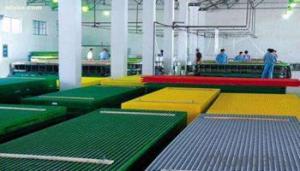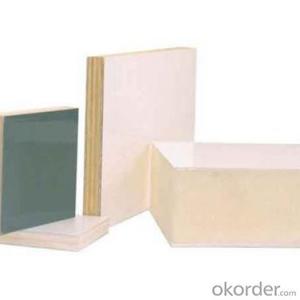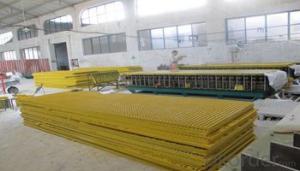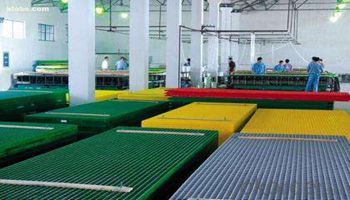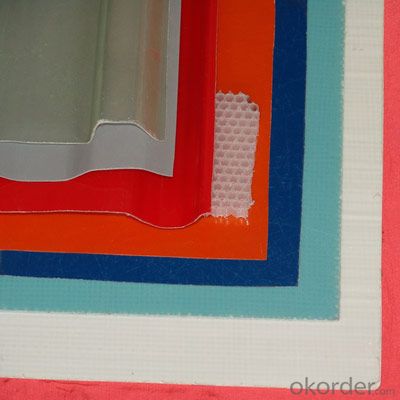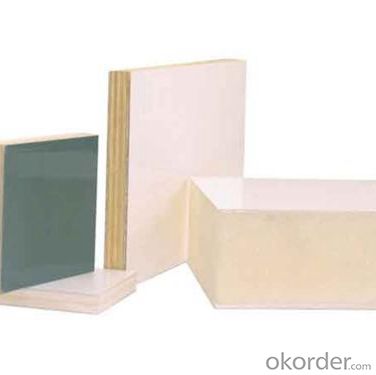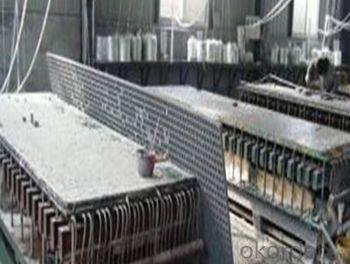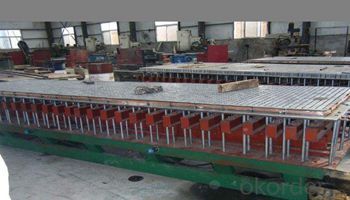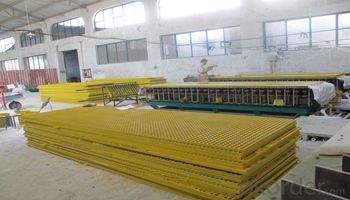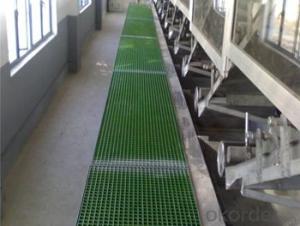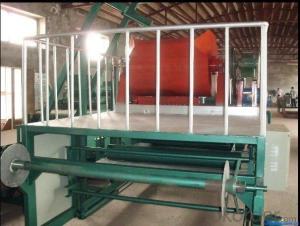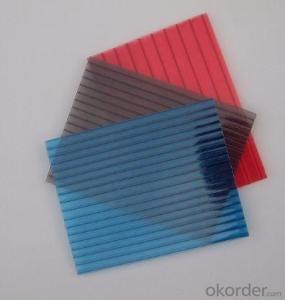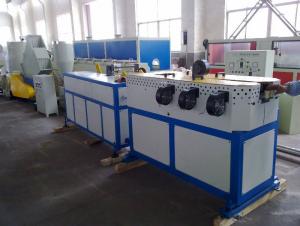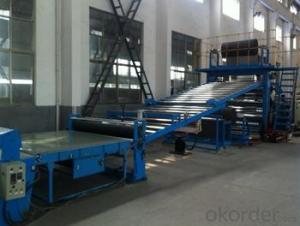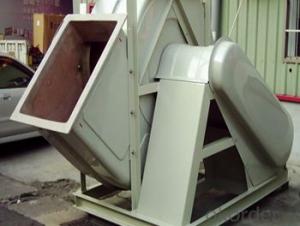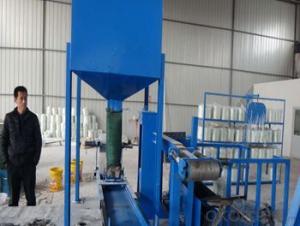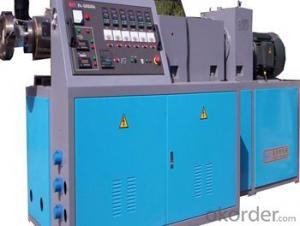FRP Pultrusion Profiles - Anti-Flammable High-Quality FRP Pultruded Grating
- Loading Port:
- Tianjin
- Payment Terms:
- TT OR LC
- Min Order Qty:
- 20000 m.t.
- Supply Capability:
- 100000 m.t./month
OKorder Service Pledge
OKorder Financial Service
You Might Also Like
Specification
PRODUCT DESCRIPTION
Pultruded grating is made by a particular assembly process, which using “I” shape as its main load-bearing and special rod to go through the bearing bar. Pultruded grating include the standard grating and the custom grating, the custom grating can be designed to meet customer’s requirement or special using condition by changing the shape, size and space of the bearing bars, the surface can be covered with lozenge panel, grit panel, or added the anti-slippery sand directly.
FRP pultruded grating has the most characteristics of molded grating, but it has its distinct advantages, it has very high fiberglass content in the loading direction, so it has very high load capability, it has more superiority when used at wide span, so that the basic support will be decreased and the project cost will be reduced accordingly.
SPECIFICATION
Thickness (mm) | Bar width (mm) | Open space (mm) | Open rate (%) | Approx weight (kg/m |
25.4 | 15.2 | 22.8 | 60 | 13.2 |
25.4 | 15.2 | 15.2 | 50 | 15.9 |
25.4 | 15.2 | 10.1 | 40 | 18.5 |
25.4 | 40 | 10.8 | 21 | 14.5 |
38.1 | 15.2 | 22.8 | 60 | 15.8 |
38.1 | 15.2 | 15.2 | 50 | 19.1 |
38.1 | 15.2 | 10.1 | 40 | 22.4 |
50.8 | 25.4 | 25.4 | 50 | 16.6 |
50.8 | 25.4 | 12.7 | 33 | 21.1 |
CHOICE FOR PULTRUDED GRATING
Resin: GP resin, ISO resin, VE resin, Phenol resin
Color choice: Yellow, gray, green, custom color
Surface choice: Groove surface, grit surface, lozenge cover surface
FEATURES
a. Anti-corrosion and anti-rust
b. Light weight and high strength
c. Anti-flammable
d. Anti- fatigue
e. Safe and anti-slippery
f. Anti-ageing
g. Easy of maintenance
h. Excellent electromagnetism property
i. Good economic benefit
FIELDS SERVED
Sewage treatment,
water supply and drainage,
chemical industry,
oil industry,
power engineering,
pulp and paper,
construction engineering,
spinning, marine engineering.
COMPANT DESCRIPTION
CNBM,China National Building Materials Group is a state-owned enterprise in charge of administrative affairs in china building materials industry. Established in 1984, CNBM is a large group corporation of building materials with total assets of 25 billion RMB and a total staff of 30,000.CNBM now owns 200 subordinating firms of solely owned and joint-venture companies.
CNBM International Corporation is one subsidiary of CNBM, we focus on offering good-quality products,professional service and complete solution to our customers. Strong delivery capacity, advanced technology& management, strong financing capability and excellent after-sale service are our advantages in sharing international market.
FAQ
1.Q:Are you factory or trading company ?
A:We are Factory produce FRP machines and FRP products.
2.Q:If can customized by customers requirements?
A:yes,we can produce the machine with customized size.
3.Q:How about the payment?
A:We accept any kind of payment.
4.Q:What is the guarantee?
A:Gurantee is one year.
5.Q:If you can training?
A:yes ,we can training in our factory also can send engineers to your factory training.
PICTURES
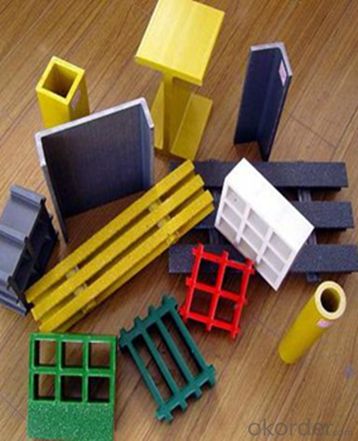
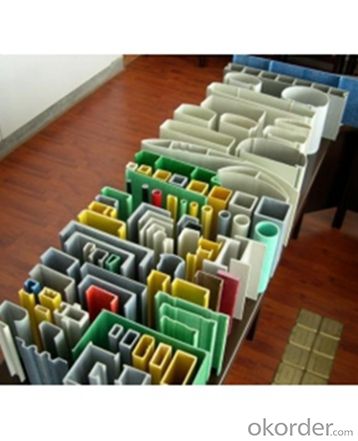
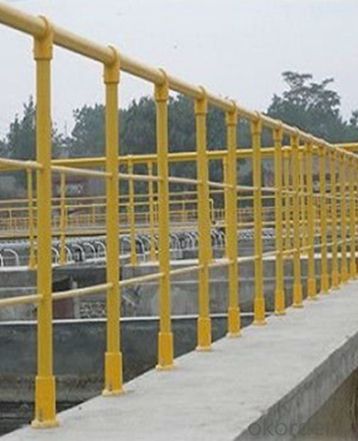
- Q: Can FRP pultrusion profiles be used in renewable energy projects?
- Certainly, FRP pultrusion profiles are capable of being used in renewable energy projects. They possess a wide range of advantages that make them suitable for various applications within the renewable energy sector. To begin with, FRP pultrusion profiles are both lightweight and strong, which makes them ideal for utilization in wind turbine blades. The lightweight nature of FRP materials allows for increased efficiency in wind energy generation by reducing the load on the turbine, thus enhancing overall performance. Furthermore, the high strength-to-weight ratio of FRP profiles ensures durability and longevity, even in severe environmental conditions. Additionally, FRP pultrusion profiles display exceptional resistance to corrosion, which renders them suitable for employment in solar panel mounting structures and other components exposed to moisture and outdoor elements. This corrosion resistance ensures that FRP profiles maintain their structural integrity and performance over an extended period, diminishing the need for frequent maintenance and replacement. Furthermore, FRP pultrusion profiles can be customized to meet specific project requirements, providing flexibility in design and functionality. They can be easily molded into complex shapes and sizes, facilitating the creation of innovative and efficient solutions for renewable energy projects. Moreover, FRP materials are non-conductive and possess excellent electrical insulation properties, making them suitable for use in electrical enclosures and support structures for renewable energy systems such as solar power plants. In conclusion, FRP pultrusion profiles can be effectively utilized in renewable energy projects due to their lightweight, strong, corrosion-resistant, customizable, and electrically-insulating properties. These characteristics make FRP profiles a reliable and sustainable choice for various applications within the renewable energy sector.
- Q: Can FRP pultrusion profiles be used in electrical or telecommunications applications?
- Yes, FRP pultrusion profiles can be used in electrical or telecommunications applications. FRP (Fiber Reinforced Polymer) pultrusion profiles have excellent electrical insulation properties and are resistant to corrosion, making them suitable for use in electrical and telecommunications infrastructure. Additionally, their light weight, high strength, and design flexibility make them a desirable choice for applications such as cable trays, support structures, and enclosures in these industries.
- Q: What are the environmental benefits of using FRP pultrusion profiles?
- Using FRP (Fiber Reinforced Polymer) pultrusion profiles offers several environmental advantages. To begin with, FRP pultrusion profiles are lightweight and possess a high strength-to-weight ratio. This means that less material is needed to achieve the same structural integrity as traditional materials like steel or concrete. Consequently, the production and transportation of FRP profiles consume less energy and result in fewer greenhouse gas emissions. Additionally, FRP pultrusion profiles exhibit exceptional durability and resistance to corrosion. This extends their lifespan and reduces the frequency of replacements required. As a result, resources are conserved, and the amount of waste ending up in landfills or requiring recycling is reduced. Moreover, FRP is non-conductive, making it an excellent alternative to metals in electrical applications. This property eliminates the risk of electrical accidents and decreases the necessity for insulation, which often involves hazardous substances. Furthermore, the manufacturing process of FRP pultrusion profiles generally requires lower energy inputs compared to other materials. The pultrusion process itself is energy-efficient, and the raw materials used in FRP production, such as resins and fibers, can be obtained from renewable or recycled sources. Lastly, FRP pultrusion profiles are chemically inert and do not release harmful substances into the environment. This characteristic makes them suitable for various applications, including water treatment plants, where preventing chemical leaching is crucial for maintaining water quality. In conclusion, the use of FRP pultrusion profiles brings about environmental benefits such as reduced energy consumption, lower greenhouse gas emissions, prolonged product lifespan, decreased waste generation, reduced dependence on non-renewable resources, and minimized chemical leaching. These advantages establish FRP as a sustainable and eco-friendly choice for a wide array of industries.
- Q: Are FRP pultrusion profiles resistant to moisture or humidity?
- FRP pultrusion profiles boast exceptional resistance to moisture and humidity. Through the pultrusion process, continuous fibers are thoroughly saturated with a polymer resin, resulting in a steadfast and enduring composite material. This composite possesses inherent moisture resistance, differing from conventional materials like wood or metal, as it does not absorb water. Moreover, FRP pultrusion profiles exhibit a minimal coefficient of thermal expansion, minimizing the likelihood of expansion or contraction in response to varying humidity levels. This moisture and humidity resistance render FRP pultrusion profiles suitable for a diverse array of applications, including outdoor structures, marine environments, and other areas prone to moisture.
- Q: Are FRP pultrusion profiles resistant to chemicals used in food processing?
- Yes, FRP pultrusion profiles are generally resistant to chemicals used in food processing. Fiberglass reinforced plastic (FRP) is known for its excellent chemical resistance, making it suitable for various industrial applications, including the food processing industry. FRP pultrusion profiles are composed of a combination of resins and fiberglass reinforcements, which provide them with inherent resistance to a wide range of chemicals. FRP pultrusion profiles are typically resistant to acids, alkalis, solvents, and many other chemicals commonly found in food processing environments. This resistance ensures that the profiles will not corrode, degrade, or react with the chemicals, preserving their structural integrity over time. This makes FRP pultrusion profiles a reliable choice for equipment, structures, and components used in food processing facilities. However, it is important to note that the specific chemical resistance of FRP pultrusion profiles can vary depending on the resin system used in their manufacturing. Different resins offer different levels of resistance to specific chemicals. Therefore, it is crucial to select the appropriate resin formulation that matches the specific chemical environment in the food processing industry. To ensure the compatibility of FRP pultrusion profiles with the chemicals used in food processing, it is advisable to consult with the manufacturer or supplier. They can provide detailed information on the chemical resistance properties of their FRP profiles and assist in selecting the most suitable materials for the specific application. Additionally, proper maintenance and regular cleaning practices should be implemented to ensure the longevity and continued chemical resistance of FRP pultrusion profiles in food processing environments.
- Q: Are FRP pultrusion profiles resistant to UV degradation?
- Yes, FRP pultrusion profiles are generally resistant to UV degradation. Pultrusion profiles made from fiberglass reinforced plastic (FRP) are manufactured using a combination of resin and glass fibers. The resin used in the manufacturing process is typically formulated to provide resistance to UV radiation. This UV resistance helps to protect the FRP pultrusion profiles from the harmful effects of prolonged exposure to sunlight. FRP pultrusion profiles have been extensively tested and have demonstrated excellent resistance to UV degradation. They are commonly used in outdoor applications where they are exposed to sunlight, such as in construction, infrastructure, and marine industries. UV resistance ensures that the FRP pultrusion profiles maintain their structural integrity, color, and aesthetic appearance over an extended period of time. However, it is important to note that the level of UV resistance may vary depending on the specific formulation of the resin used in the manufacturing process. Different manufacturers may use different resins with varying levels of UV stabilizers. It is recommended to consult with the manufacturer or supplier to ensure that the specific FRP pultrusion profiles being used are designed to withstand the UV conditions of the intended application. Regular maintenance and periodic inspection of the FRP pultrusion profiles are also important to ensure their long-term UV resistance. This may include cleaning, applying protective coatings, or using UV-blocking additives if necessary. By taking these precautions, the UV resistance of FRP pultrusion profiles can be further enhanced, ensuring their durability and longevity in outdoor environments.
- Q: How do FRP pultrusion profiles withstand extreme temperatures?
- FRP (Fiber Reinforced Polymer) pultrusion profiles are engineered to withstand extreme temperatures due to the unique properties of the materials used in their construction. Firstly, FRP pultrusion profiles are composed of a combination of reinforcing fibers, such as fiberglass or carbon fiber, and a polymer resin matrix. These fibers provide excellent strength and stiffness, while the resin acts as a protective binder, holding the fibers together and providing resistance against heat. The reinforcing fibers used in FRP pultrusion profiles have high melting points and are inherently non-combustible, allowing them to maintain their structural integrity even at elevated temperatures. This characteristic prevents the profiles from melting, warping, or becoming brittle under extreme heat conditions. Additionally, the polymer resin matrix used in FRP pultrusion profiles is carefully selected to have a high glass transition temperature (Tg). The Tg is the temperature at which the resin transitions from a rigid, glassy state to a more flexible, rubbery state. By utilizing a resin with a high Tg, FRP pultrusion profiles can withstand extreme temperatures without losing their mechanical properties. Furthermore, the manufacturing process of pultrusion itself contributes to the ability of FRP profiles to withstand extreme temperatures. During pultrusion, the reinforcing fibers are carefully impregnated with the resin matrix and then pulled through a heated die. This process ensures a uniform distribution of the resin throughout the profile, enhancing its resistance to heat and temperature fluctuations. Overall, the combination of high-performance reinforcing fibers, a carefully selected resin matrix, and the pultrusion manufacturing process enables FRP pultrusion profiles to withstand extreme temperatures, making them suitable for a wide range of applications in various industries.
- Q: How do FRP pultrusion profiles handle bending and flexing?
- FRP (Fiber Reinforced Polymer) pultrusion profiles are highly durable and can handle bending and flexing quite effectively. The unique manufacturing process of pultrusion, which involves pulling reinforcing fibers through a resin bath and then curing it in a heated die, results in a composite material with exceptional strength-to-weight ratio. When it comes to bending, FRP pultrusion profiles exhibit excellent flexibility. The reinforcing fibers, such as fiberglass or carbon fibers, provide the necessary tensile strength to resist bending forces. Additionally, the resin matrix that surrounds the fibers provides a degree of elasticity, allowing the profiles to flex without breaking or permanently deforming. The specific design of the pultrusion profile also influences its bending and flexing capabilities. By varying the arrangement, orientation, and number of reinforcing fibers, manufacturers can tailor the profiles to meet specific application requirements. This allows for enhanced strength and flexibility in desired directions while maintaining structural integrity. Furthermore, FRP pultrusion profiles offer inherent resistance to corrosion, moisture, and chemicals, making them ideal for applications in harsh environments. These properties ensure that the profiles do not weaken or degrade over time, even when subjected to repeated bending and flexing. Overall, FRP pultrusion profiles are well-suited for handling bending and flexing due to their inherent strength, flexibility, and resistance to environmental factors. Their ability to maintain structural integrity under such conditions makes them a reliable choice for various industries, including construction, infrastructure, aerospace, and automotive.
- Q: Can FRP pultrusion profiles be used in the construction of stadium seating?
- FRP pultrusion profiles offer a range of benefits that make them suitable for constructing stadium seating. Firstly, their lightweight yet strong composition is ideal for accommodating a large number of seats. This lightweight feature facilitates easier handling and installation, ultimately saving time and effort during construction. Secondly, FRP pultrusion profiles possess exceptional durability and corrosion resistance, making them well-suited for outdoor applications like stadium seating. Their ability to withstand rust, rot, and degradation from moisture, UV rays, and chemicals commonly found in stadiums ensures a long-lasting seating solution. Moreover, the non-conductive properties of FRP pultrusion profiles provide an added safety advantage, particularly in areas with electrical wiring. This reduces the risk of accidents or electric shocks associated with conductive materials. Additionally, the versatility of FRP pultrusion profiles allows for customization to meet specific design requirements, offering flexibility in stadium seating layouts. They can be manufactured in various shapes, sizes, and colors to align with both aesthetic and functional needs. Lastly, FRP pultrusion profiles boast a long service life with minimal maintenance requirements, resulting in a cost-effective choice for stadium seating in the long term. In conclusion, due to their lightweight, durable, non-conductive, customizable, and cost-effective nature, FRP pultrusion profiles are an excellent option for constructing stadium seating.
- Q: Can FRP pultrusion profiles be used in the construction of pedestrian bridges?
- Pedestrian bridges can utilize FRP pultrusion profiles, which offer numerous advantages for bridge construction. Firstly, these profiles are lightweight yet incredibly strong and durable, making them ideal for weight-sensitive pedestrian bridges. The lightweight nature of FRP profiles also simplifies transportation and installation, resulting in cost savings. Secondly, FRP pultrusion profiles are corrosion-resistant, a critical factor in bridge construction. Unlike traditional materials such as steel or concrete, FRP does not rust or corrode, even in harsh environments. This property significantly prolongs the lifespan of pedestrian bridges while reducing maintenance costs. Moreover, FRP pultrusion profiles provide design flexibility. They can easily be tailored to meet specific project requirements, allowing for the creation of unique and innovative bridge designs. The material can be molded into various shapes and sizes, enabling the construction of aesthetically pleasing pedestrian bridges. Furthermore, FRP pultrusion profiles possess excellent mechanical properties, including a high strength-to-weight ratio and fatigue resistance. This ensures that the bridge can withstand the loads and stresses imposed by pedestrian traffic over an extended period. Lastly, FRP pultrusion profiles are non-conductive, making them a safe choice for pedestrian bridges. In areas where there are overhead power lines or electrical equipment, the non-conductive nature of FRP reduces the risk of electrical accidents. In conclusion, FRP pultrusion profiles are a suitable option for constructing pedestrian bridges due to their lightweight, corrosion-resistant, customizable, and mechanically strong properties. Their usage can result in durable, low-maintenance, and visually appealing bridges that provide a safe and efficient means of pedestrian transportation.
Send your message to us
FRP Pultrusion Profiles - Anti-Flammable High-Quality FRP Pultruded Grating
- Loading Port:
- Tianjin
- Payment Terms:
- TT OR LC
- Min Order Qty:
- 20000 m.t.
- Supply Capability:
- 100000 m.t./month
OKorder Service Pledge
OKorder Financial Service
Similar products
Hot products
Hot Searches
Related keywords
